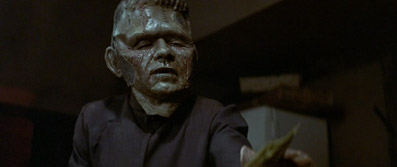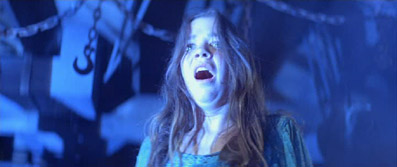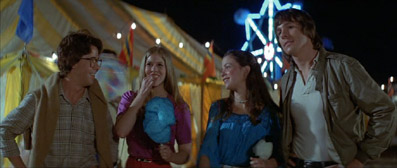|
You
have to feel for Tobe Hooper. There's an argument for casting
him as the Orson Welles of horror cinema, a director
who made such a splash with his breakthrough film that everything
he subsequently directed ended up being unfavourably compared
to it. Everyone wanted another Texas Chain Saw Massacre,
but there just can't be one. This was the sort of career-launching
one-off that could only be made by a young newcomer, one armed with the sort of bravery and vision that the film industry does its damndest to subsequently strip you of. Witness the tardy sequels, the first of which Hooper directed, and the stodgy remake for confirmation.
Following
rumours of a Spielberg overthrow on the 1982
Poltergeist and a bungled remake of Invaders
from Mars, most of Hooper's subsequent work has
been confined to TV, directing episodes from the likes of
Tales From the Crypt, Amazing Stories,
Night Terrors, Masters of Horror
and a slew of others. When he has intermittently returned
to movie making, such as with the 1993 Spontaneous
Combustion and the 1995 The Mangler,
the brickbats have landed with considerable force. It's
too easy to forget that in his pre-Poltergeist days, Hooper was still a director who commanded genre fan
attention. Following the commercial misfire of his second feature, Eaten Alive (which is still well worth a look
for dedicated horror enthusiasts), he directed two films
that showcased his ability to produce standout work even
within the confines of convention. The first was the 1979
TV movie Salem's Lot, one of the most enjoyable
of all Stephen King horror adaptations. The second was the
1981 theatrical feature, The Funhouse.

Putting
teenagers in peril and systematically killing them off in
creative fashion was still popular in the early 1980s, and
a superficial reading of The Funhouse would
certainly paint it as being part of this cycle. You'll only
need to have seen a handful of genre films from the period
to recognise a few of the touchstones here. Teenager
Amy Harper is off for a night out at the local carnival with her friends Buzz,
Liz and Richie, despite warnings from
her father to steer clear of the place. It is, after all, the same carnival where
they found the bodies of those two little girls when it went through Fairfield last year, he reminds
her, a bit of exposition that's more for the audience than
his presumably well-aware daughter. Amy and her friends go anyway and have a real good time, but to
complete the evening decide it might be fun to spend the
night in the carnival's funhouse, which Liz suggests will
give Amy, who's first-dating the hunky Buzz, a chance
to finally lose her virginity. Once the carnival closes,
the four get down to business, but are disturbed when the
deformed son of the funhouse owner kills carnival fortune
teller and part-time prostitute Madame Zelda (Sylvia Miles)
in the office located directly beneath where they have chosen to hide. Figuring it might
be time to get the hell out of there, a moment of clumsiness betrays
their presence and a deadly game of cat-and-mouse between them and the funhouse owner begins.
All
of which sounds like the formula for a standard 80s slasher
flick, with thrill-seeking teenagers ignoring the advice of their elders and ending up being stalked by a monster,
while the virginal female is destined to escape death while her
more promiscuous, pot-smoking companions perish. But there's
more going on here than meets the synopsis, and The
Funhouse differs from that particular genre standard
in a number of significant ways. The
characters and plot are certainly established along traditional
lines, but Hooper then plays some interesting games with
convention. For a start, despite being comprised of the stock
quartet of tart, virgin, wisearse and jock, his teenage
protagonists are a likeable group and pleasingly underplayed,
at least when compared to the genre standard. Elizabeth Berridge in particular
makes for the most sympathetic heroine this side of Jamie
Lee, while as the muscled-up Buzz, Cooper Huckabee kicks
against expectations by suggesting there's a decent guy
underneath his swagger. You actually don't have an urge
to see these kids killed.

The
monster, meanwhile, despite its grotesque appearance (courtesy
of makeup wizard Rick Baker) and brief fits of uncontrolled
anger, is both humanised and humiliated, and for the most
part proves to be sheep in wolf's clothing, a living funhouse
exhibit whose function is primarily to terrify rather than
attack the teenagers – when he does kill it's always the
result of provocation. It's the creature's relationship
with his father (played by the splendid Kevin Conway, the unnerving face of every barker in the carnival)
that provides the most direct link to Texas Chain Saw,
a bond of blood that transcends issues of morality and proves
considerably stronger than the fragile ties of friendship
on which the teenagers have to rely.
Such
generic disruption is used by Hooper as the basis for an
intriguing exploration of dual notions of screen horror,
with the safe, artificial and marketable elements repeatedly undercut
by a darker reality that lies beneath. This is brilliantly
captured in an opening sequence that lingers on a plethora
of genre memorabilia, then directly parodies iconic imagery from
Halloween and Psycho,
and concludes by forcing the innocent Amy to confront an
ugly image of her own monster within, her face frozen by Palaroid photo in
a distorted portrait of hateful rage. The duality is followed
through in a creature whose horrific true self is hidden
beneath the almost comically cheap costume of the Frankenstein
monster, and in the funhouse itself, whose
contents are initially the source of mocking amusement but develop an aura of childhood nightmare once the killing
begins.
Hooper
delights in the lights and music and sometimes surrealistic
potential of his carnival location, clearly having a particular
affection for the animatronic marionettes that populate
the opening credits and provide creepy, key moment cutaways.
It's the same story for the supporting cast, which is sprinkled
with whacked-out oddballs included solely for texture, the
star turn coming from early De Palma favourite William Finley
as eccentric, drink-swigging magician Marco the Magnificent.

There
are a couple of narrative dead ends – younger brother Joey's
covert trip to the carnival appears staged largely for us to enjoy his confusion at his sister's disappearance and to set up a
can't-hear-the-shouts scene when his parents arrive to collect
him – and the scare factor has inevitably been diluted by
our familiarity with the formula and films it toys with.
But in other respects, The Funhouse has
stood the test of time well. Its narrative energy, restrained
performances and visual and thematic richness give it
both longevity and replay value, while its effortless eccentricity
and flashes of black humour qualify it as vintage Hooper,
his last such work before being swallowed by the Spielberg
machine.
At
last. After many years of suffering the cropped
4:3 VHS version finally we finally get to see the film presented as it should
be – 2.35:1, anamorphically enhanced and looking great.
Contrast, detail and colour are all rather lovely, and black
levels are bang on without loss of shadow detail. There
is some visible grain in places, but it's never intrusive.
Even saturated reds and blues look good.
The
soundtrack is Dolby stereo 2.0 only, but it's a clear one
with a decent dynamic range and distinct separation in places.
None.
Always a shame.
An
old favourite that still holds up and acts as a useful reminder
of how in tune with the horror genre Tobe Hooper was and
how much fun he could have with it given the right material.
As for the DVD, well the extra features cupboard is empty,
but the transfer is what fans have been waiting for, so
I'm happy enough.
|